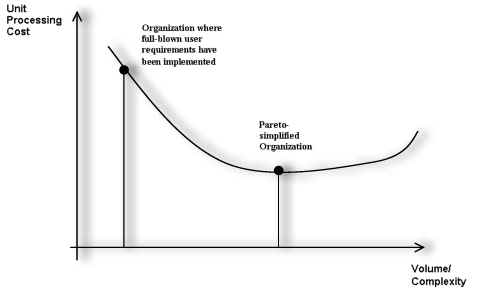
Prepare for IT Automation
A problem left to itself dries up or goes rotten. But fertilize a problem with a solution - you'll hatch out dozens.
Two key parameters influence the efficiency - and therefore the R.O.I. - of business automation:
- the volume processed
- the processing complexity
The larger the amount of data on which routine operations need to be performed, the more justified it is to automate the corresponding processes. However the cost of automation increases as this algorithmic processing gives rise to a combinatorial explosion of situations that need to be addressed specifically i.e. as the algorithmic complexity increases.
The ratio volume/complexity
is therefore key in assessing the interest of business automation. In some cases a semi-manual solution (e.g. data stored and exchanged on spreadsheets) can be much more cost efficient than a fully integrated, state-of-the-art automation. Even though clerical staff does not come out cheap, its cost pales before the cost required to design, implement, maintain and manage information systems. This might sound like a plea to find the right trade-off between manual and automated operation. Actually, our message goes much further: an organization is free, to a significant extent, to set that optimum trade-off point to a position that best suits that organization.
A Pareto optimization engagement simplifies (or de-complexifies) business processes to a point where the “volume/complexity” ratio becomes much more favorable to comprehensive business automation. Simply put, instead of partially automating complex processes, the organization can now fully automate de-complexified processes. De-complexification translates itself in an optimization of the customer value/cost
ratio (see the heuristics of our approach). This is not to be confused with a defeatist surrender because the requirements might be too hard to meet in a full automation scenario. Pareto optimization ensures that requirements are met inasmuch as it makes economic and business sense.
IT Cortex business pre-automation service reduces significantly the unit processing cost of the to-be-implemented package by preventively de-complexifying the organization. This always reduces drastically the cost of a large software implementation.

Additional tangible and intangible benefits achieved by performing a de-complexification process prior to a software roll-out are :
- shortening of the delivery duration
- more intelligible reports
- less training effort
- more manageable documentaion
Ultimately those benefits get internalized in the overall cost of the business automation.
In the case of a new package implementation a key activity in our business pre-automation engagements consists in performing variance analysis between the generic model of the to-be-implemented package and the organization's actual processes and ad hoc activities. As many organizations have discovered the hard way
it is easier and cheaper to bend an organization to a package than to bend a package to meet organizational idiosyncrasies (provided of course that the top management has the commitment to harness the complexity drivers present within an organization).
Remark:
Besides volume and complexity other parameters can weigh on the overall cost of business automation like:
- the nature of the processes to be automated
- the rate of change of business processes
- the professional expertise of the IT staff
- the sophistication level of the user community
These parameters are nevertheless less relevant than the the key ones: namely volume and complexity.
If you want to get more information over this service do not hesitate to contact us.